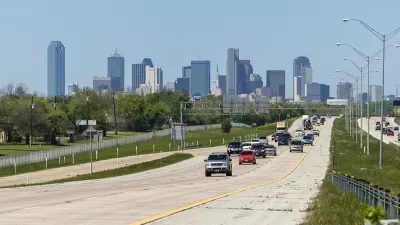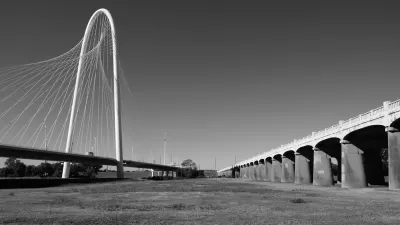Dallas reached another milestone in its years-long battle over a proposal to build a toll road through a park along the Trinity River on the edge of downtown. The latest version of the proposal so far hasn't cleared any controversies.
"At a meeting of the Transportation and Trinity River Project Committee, 12 of 15 council members heard from urban planner Larry Beasley about his so-called Dream Team’s new plan for the Trinity Parkway," reports Robert Wilonsky, who also offers a critical opinion of the results of their work: "which still looks and feels and sounds a lot like the highway everyone hated so much that Mayor Mike Rawlings called for this do-over."
After a year of work by a collection of planners and engineers, along with an appointed advisory committee, the Dream Team produced the following conceptual proposal:
The road will be four meandering lanes. Traffic will move at 45 miles per hour. There will only be a handful of on-and-off ramps. There will be trees everywhere. There will be U-turns and shoulder pull-over spots for those wanting to enjoy so-called “WOW” views. There won’t be trucks. There won’t be tolls. There will be park access.
Except Wilonsky remains skeptical that the talking points offered by the Dream team will live up to the reality of the proposal, if the proposal should be realized. Wilonsky writes:
Because, you see, that meandering road really doesn’t meander. And the lanes are wide and only getting wider — from 10 and 11 feet discussed last year to 11 and 12 feet in the latest iteration. And the proposed grass shoulders will probably wind up being gravel.
Wilonsky offers additional details about the park planning occurring concurrently as the road planning, and also previews potential next steps for the so-called "Dream Team."
FULL STORY: Wilonsky: The Dream Team’s Trinity Parkway still looks like nightmare toll road everyone hated

Alabama: Trump Terminates Settlements for Black Communities Harmed By Raw Sewage
Trump deemed the landmark civil rights agreement “illegal DEI and environmental justice policy.”

Study: Maui’s Plan to Convert Vacation Rentals to Long-Term Housing Could Cause Nearly $1 Billion Economic Loss
The plan would reduce visitor accommodation by 25% resulting in 1,900 jobs lost.

Why Should We Subsidize Public Transportation?
Many public transit agencies face financial stress due to rising costs, declining fare revenue, and declining subsidies. Transit advocates must provide a strong business case for increasing public transit funding.

Paris Bike Boom Leads to Steep Drop in Air Pollution
The French city’s air quality has improved dramatically in the past 20 years, coinciding with a growth in cycling.

Why Housing Costs More to Build in California Than in Texas
Hard costs like labor and materials combined with ‘soft’ costs such as permitting make building in the San Francisco Bay Area almost three times as costly as in Texas cities.

San Diego County Sees a Rise in Urban Coyotes
San Diego County experiences a rise in urban coyotes, as sightings become prevalent throughout its urban neighbourhoods and surrounding areas.
Urban Design for Planners 1: Software Tools
This six-course series explores essential urban design concepts using open source software and equips planners with the tools they need to participate fully in the urban design process.
Planning for Universal Design
Learn the tools for implementing Universal Design in planning regulations.
Smith Gee Studio
Alamo Area Metropolitan Planning Organization
City of Santa Clarita
Institute for Housing and Urban Development Studies (IHS)
City of Grandview
Harvard GSD Executive Education
Toledo-Lucas County Plan Commissions
Salt Lake City
NYU Wagner Graduate School of Public Service




























